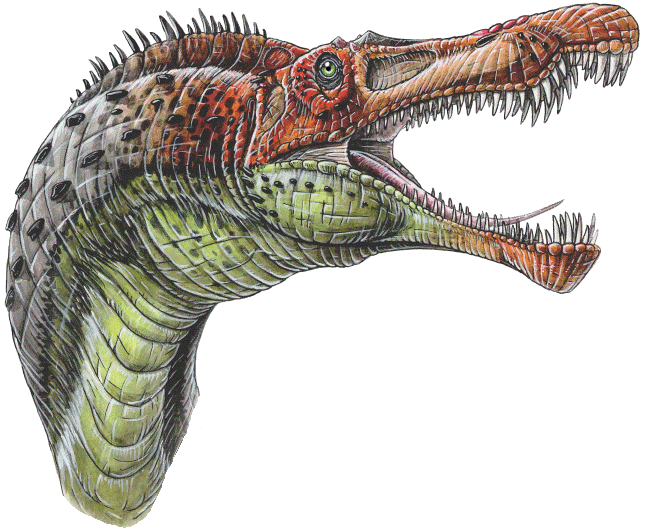|
Baryonyx walkeri (Charig
and Milner, 1986) |
 |
|
Name Means: |
"Heavy Claw" |
Length: |
40 feet (12 m) |
|
Pronounced: |
Bear-ee-On-ix |
Weight: |
4 tons (3,600 kilos) |
|
When it lived: |
Early Cretaceous - 120 MYA |
|
|
|
Where found: |
Surry, England |
|
|
|
Baryonyx was the first carnivorous
dinosaur to be discovered in England. It was an unusual theropod with huge foot-long claws on its hands. Most
theropods had S-shaped necks, but Baryonyx had a long straight one
that was fairly inflexible. The design of its hips and pelvis
suggests that it was bipedal for the purposes of walking from place to
place. However, its forelimbs were absurdly large for a theropod,
suggesting that it also spent much of its time on all fours. It
had a long long tail and a low-slung body.
The skull was set at an acute angle, not the 90° angle common in
similar dinosaurs. The long jaw was distinctly crocodilian, and had 96
teeth, twice as many as its relatives. Sixty-four of the teeth were
placed in the lower jaw (mandible), and 32 large ones in the upper
(maxilla). The snout probably bore a small but distinctive crest.
The crocodile-like jaws and large number of finely serrated teeth
suggested to scientists that Baryonyx was a fish-eater. As
confirmation, a number of scales and bones from the fish Lepidotes
were also discovered in the body cavity. Some believe that Baryonyx
would sit on a riverbank, resting on its powerful front legs, and then
sweep fish from the river with its powerful striking claw. This is the
same fishing technique used by modern grizzly bears. The long but low
stance and angled head support this theory. Interestingly,
Iguanodon bones were found with the Baryonyx skeleton,
suggesting that it may have scavenged any extra meat it could find.
Baryonyx was discovered by William Walker, an amateur fossil
hunter, in 1983. He found an enormous claw sticking out the side of a
clay pit. He retrieved the specimen, which was surprisingly
intact. He took it to the Natural History Museum in London,
where it was examined by Alan J. Charig and Angela C. Milner.
About 70 percent of the skeleton was later recovered, including the
skull. The bones were fossilized in an unnatural position, so
the paleontologists reconstructing it placed them on the front feet
because these legs were so powerful. The bone structure suggests a
massive bulk of muscle ran down the sides of these front legs. It was
and is the only known specimen and it seems to have been a
juvenile, so the upper limits of its size are still unknown..
Charig and Milner published their description of the type species,
B. walkeri, in 1986, and named it after Walker. There is
only one specimen of Baryonyx, so there is little debate about
classification. There is a similarity to the tetanuran Becklespinax,
but there is no evidence that Baryonyx had similar elongated
spines on the back of its neck.
Baryonyx was the only known piscivorous (fish-eating)
dinosaur until the discovery of the closely-related Suchomimus.
It was another crocodile-like fish-eater. Described
in 1998, it was placed in the same subfamily (Baryonyichae). It has
recently been suggested that Suchomimus tenerensis should be
redefined as Baryonyx tenerensis due to similarities in their
vertebrae. |
|
|
|
|
|
|
|
|
Edugraphics.Net | Feenixx Publishing |
|
|
|